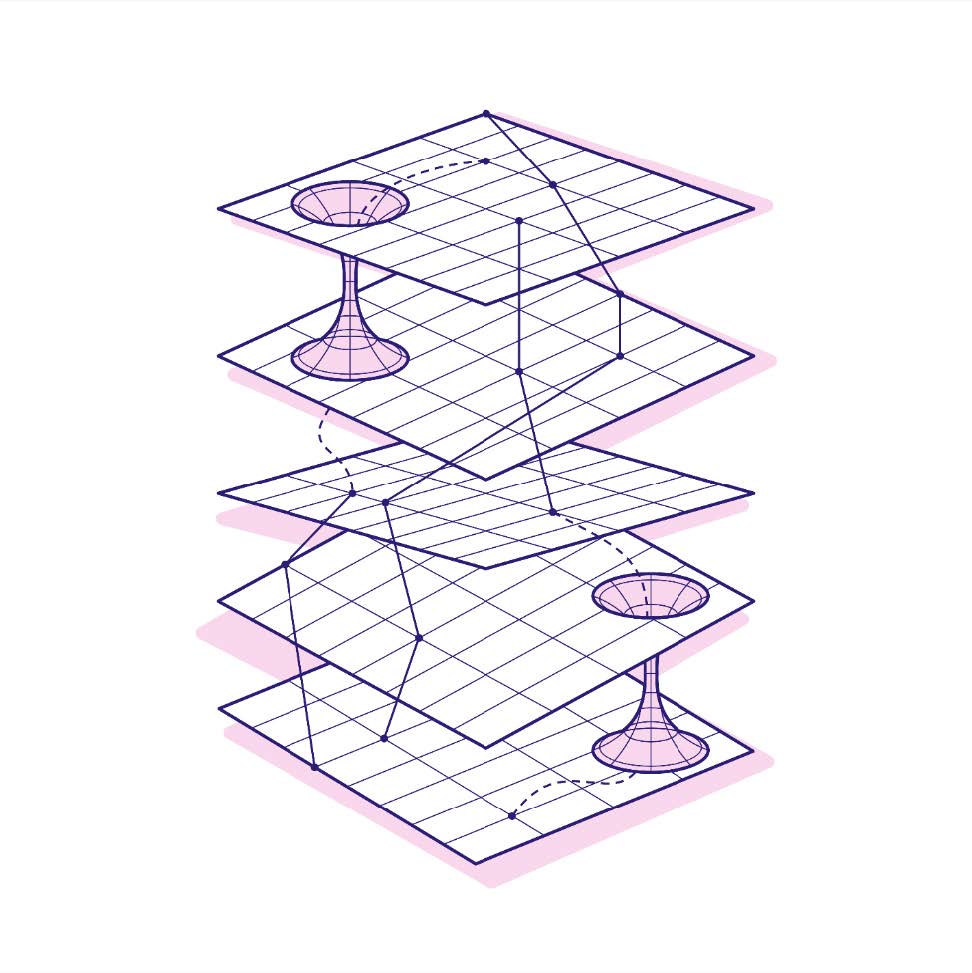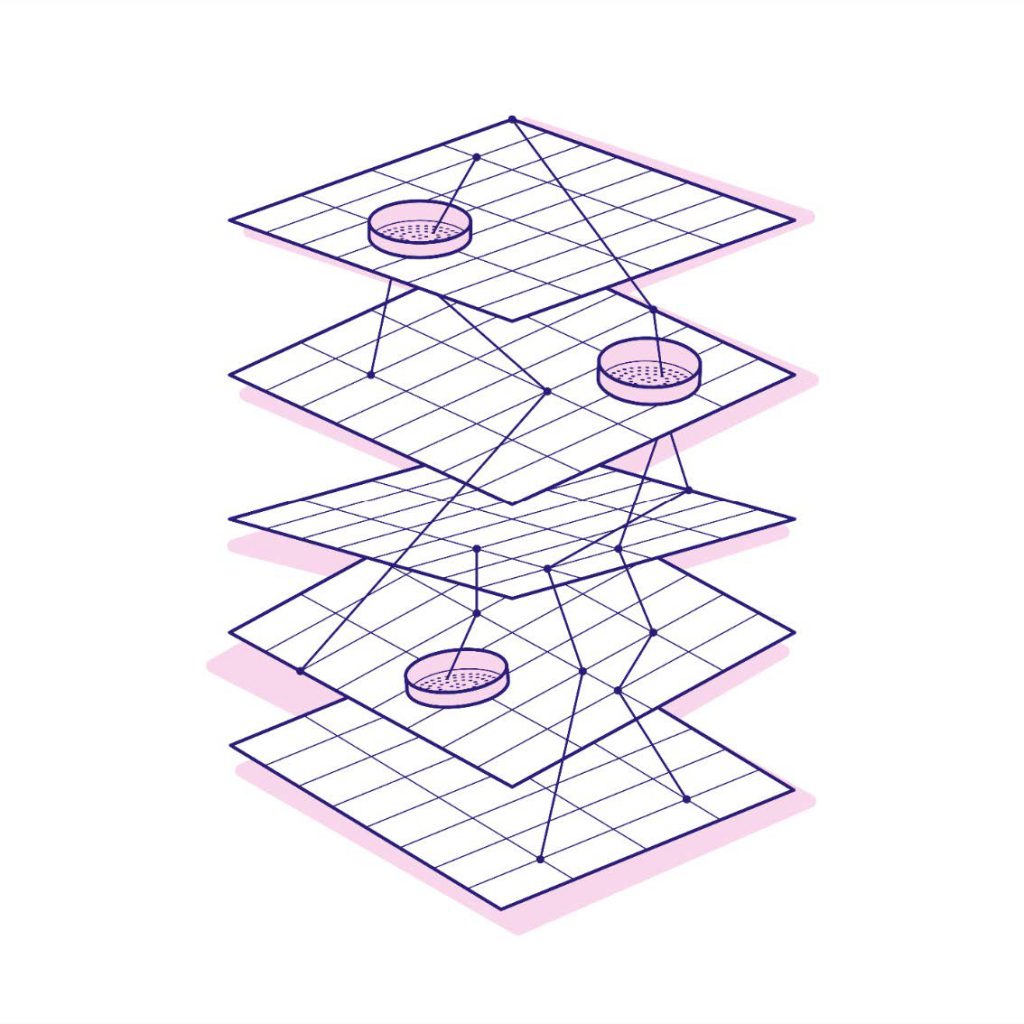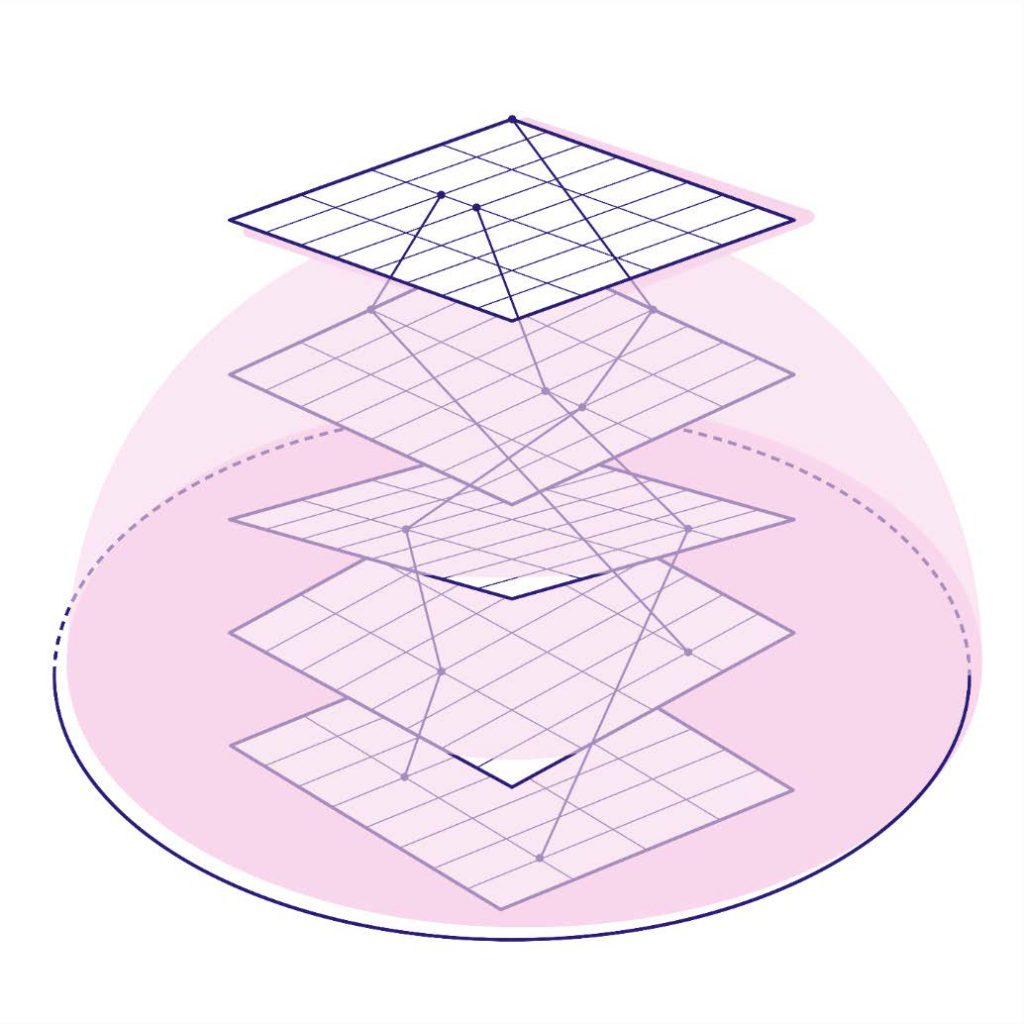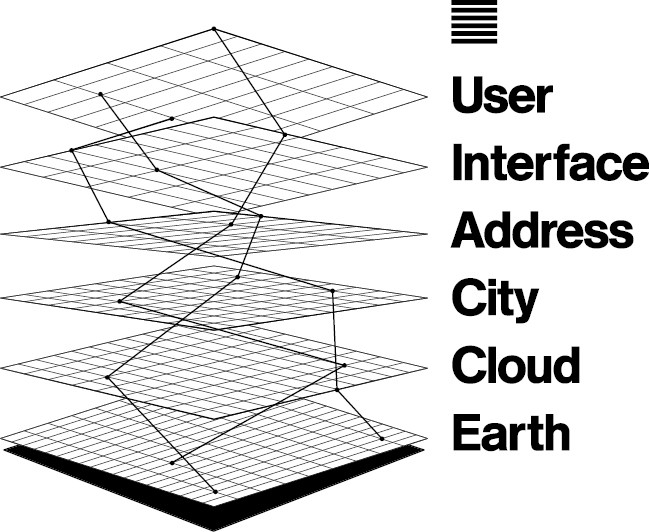抖音拓扑:网关、筛子、圆顶 | A topology of TikTok: Gateway, sieve, dome
An article with a rather long history has come out on the International Journal of Communication: titled “Gateways, sieves and domes: On the infrastructural topology of the Chinese stack“, it’s part of a special section on the “infrastructural politics of liminality” edited by Rolien Hoyng that I heartily recommend as a whole weekend worth of reading. I am usually happy with letting my academic publications stand in their own incompleteness, but in this case the stretched writing timeline and several rounds of word-count chiseling warrant some updates. I presented the main hunch behind this article at a workshop in Hong Kong in 2017 – I had just finished reading Benjamin Bratton’s The Stack, and I felt compelled to think about Chinese digital infrastructure through the lens of planetary computation. Bratton’s book closes with a meditation on the “Black Stack” to come, and around the same time Tiziana Terranova was writing about an aspirational “Red Stack” for the post-capitalist commons. As research on the Chinese internet moved from web content and social media to emerging platforms and infrastructural assemblages, the times seemed ripe to explore new frames of reference. Was a ‘red stack’ already coming together in China, as decades of state-promoted informatization and technological leapfrogging interlocked with the homecoming of tech entrepreneurs and the inflows of global venture capital?
After reviewing subsequent discussions of The Stack (and of stacks more generally), it became clear that the point was not to read the Chinese context through the stack model, nor to develop a Chinese version of it. Instead, postulating planetary computation as an “accidental megastructure” (Bratton, 2015) allowed for a different kind of speculative inquiry into how transnational governance, national borders, state jurisdiction, sovereignty, citizenship and usership were being reshaped by shifting layers of digital mediation. For a couple of years, this idea remained a growing collection of notes and paragraph drafts. I ended up ditching the ‘red China’ trope and the reduction to techno-nationalist explanations it often signifies, and I tried approaching the question from the other way around: how was Chinese digital infrastructure contributing to planetary computation, and which details could it reveal about this emerging assemblage? One way of doing this was understanding the stack topologically. My use of topology here does not directly refer to the branch of mathematics studying the deformation of objects nor to the logical configuration of computer networks (although the slippage makes the term enticing); rather, it borrows it from ANT-adjacent cultural and media theorists who have embraced topology as both a model and a method to articulate the coming together of complex sociotechnical assemblages.
For Bratton, the stack is clearly a topological model. As neither a descriptive diagram nor a cospiratorial masterplan, the stack challenges topographic representations of computational infrastructure; in his words:
as the geography of the Cloud rotates from a two-dimensional map to a vertical, sectional stack, its topography is shaped by the multiplication and superimposition of layers of sovereign claims over the same site, person, and event. The micro-enclaves that it spawns are variously exclusive or inexclusive, a pixelated patchwork of discontiguous partial interiors.
(2015, p. 373)
The two main topological configurations identified by Bratton confirm this topological approach: both the “layers” (Earth, Cloud, City, Address, Interface, User) affording vertical patchworks of sovereignty and the “columns” traversing them in unique trajectories are devices that highlight the relational and discontinuous enrollment of sociotechnical spaces. As Will Straube argues, the goal of developing this sort of analysis is not so much applying spatial metaphors to computational infrastructure, but rather to “engage with and draw out specific spatial articulations encountered within the various inscriptions of digital devices” (2016, p.7). This is precisely what I attempted to do in my article, by proposing three additional topological configurations of the stack – the gate, the sieve, and the dome – which I derive from the geopolitical history of the internet in China.
In the tortuous process of writing this piece, I ended up drawing on distinct and heterogeneous examples: a submarine cable as topographical foil, the QR code as infrastructural gateway, algorithms as multi-scalar sieves, and cyber-sovereignty as a geopolitical dome. Overall, this is a messy collection of tenuously correlated examples. It was only when the article was in press that I realized a single entity could become the perfect case study for this approach: ByteDance’s TikTok product and its global journey from social media app to AI-powered national security threat. While the article closes with a speculative proposal, revisiting my argument through the case of TikTok hopefully offers a practical use for these topological imaginaries, especially when they are applied to entities that transcend established categories of sociotechnical analysis: apps that are more than an app, infrastructures nested between the national and the global, software-as-a-service-as-sovereignty, platforms that become utilities, cryptocurrencies mined with geothermal energy, and so forth. In this addendum, I briefly introduce the gateway, the sieve and the dome by way of TikTok, attempting a topological analysis of this contested and unlikely outgrowth of planetary computation; if any of these tangents pique your interest, more substantive lines of argument and references are in the full article, which is luckily open access.

TikTok as gateway
In the topology of the stack, a gateway can be imagined as a sort of funnel or wormhole that facilitates access, shortening or even collapsing the space between layers and across jurisdictional boundaries. I borrowed this term from infrastructure studies, where gateways are theorized as elements allowing the integration of two or more systems, which tend to move from flexibility to solidification and allow isolated systems to become – you guessed it – infrastructure. Socket plugs and ISO containers are gateways, and when it comes to computational infrastructure, QR codes are gateways as well: created by a Japanese company as a machine-readable aid for increasingly information-intense logistics, QR codes have been almost accidentally enrolled into the stack through the fortunate experimentation of social media platforms such as LINE and WeChat. Scanning a QR code (first with your eyes, as an emplaced marker of access to a certain service, then with your mobile device) directs a column through various layers of the stack: money from a credit card is transferred to an escrow system owned by a platform which in turn confirms your purchase with a vendor and sets off a chain of logistics; your health status is retrieved from a national database and shared with a foreign airline; your new acquaintance receives a friend request. More than a camouflaged hyperlink, QR codes are gateways that shorten paths between users and services, routing around more established social and economic infrastructures, and expanding the reach of new systems across layers. But how is this relevant for TikTok?
Apps can be gateways too. With its notoriously captivating interface, TikTok offers access to several services: primarily, entertaining content, but also social connections with fellow viewers and creators, a feeling of belonging to algorithmically-tailored communities of interest, and (most evidently in Douyin, the Chinese version of the app) e-commerce, with the integration of influencer economies and object recognition powering new forms of consumption. The app is free and readily available across operating systems; its function as a gateway is granted in exchange for user activity, the tried-and-tested business model of many social media platforms – every tap, scroll, replay, comment, like and follow (alongside less evident interactions with its interface) becomes data to be monetized by the company. Your access through the gateway is the product. As many other low-threshold platforms affording the production and dissemination of content, TikTok’s role as gateway disturbs established jurisdictions across different layers: a clear example are the recurring panics about users being able to access problematic content with no possibility of external oversight. The popularity of short video as a format is simply the carrier for an expanding variety of content and services, and the app’s much-touted algorithmic recommender system is expanded with a search function, granting users more agency in discovering information. As product manager Kelly Zhang explains, Douyin’s recent launch of an active search engine highlights the app’s ambition of becoming “the index of the book, the gateway to finding answers and reaping new knowledge” (Liao, 2021), challenging established web search giants such as Baidu. And yet, gateways often encounter infrastructural resistance; for TikTok, this is most evident in the splitting into non-interoperable app versions operating in different markets, which limit the reach of its topological effects.

TikTok as sieve
Sieves operate at a similar scale as gateways – in between layers, modulating columns as they travel through the stack – but their function is not to facilitate access and route around established pathways; instead, sieves split and redirect data and activity according to situated governance protocols. In this case, the term comes from anthropologist Paul Kockelman, who has defined sieves through his work on the Bayesian equation and its role in computational algorithms. For Kockelman, the sieve is both a physical device and an analytical concept (2013, p. 34) that can help unpack the functioning of heterogeneous constructs ranging from border checkpoints to prescriptive grammars. In the case of China’s digital infrastructure, the flexibility of this concept allows to identify sieves in (and between) all layers of the stack: user identity verification, interfacial terms of consent, IP address restrictions, algorithmic platform governance, state regulations and, obviously, the well-documented filtering systems and censorship mechanisms. Understanding all these instances of selective modulation as sieves has two advantages; first, it allows to frame the assemblage of technical solutions and institutional practices known as the ‘Great Firewall’ in a broader, pervasive logic of the stack; secondly, it highlights how the history of digital infrastructure in China has rendered sieves even more central and legible, arguably as a way to enforce user compliance and reinforce jurisdictional claims. Moreover, again following Kockelman, the effects of multiple sieves are not necessarily additive, and their proliferation at all layers of the stack can result in counterproductive outcomes such as making censorship visible and thus easily mocked and bypassed, or even imprinting columns with the very same information they were designed to screen out.
How is TikTok relevant here? First of all, the core value proposition of ByteDance’s apps – a recommender system capable of constantly fine-tuning its content offerings through machine learning applied to user interaction data – is obviously an algorithmic sieve. Key to the platform’s success and regularly updated to ensure maximum retention of both creators and users by carefully weighing novelty and repetition, this sieve is so prominent and uncanny that users experience it as an affordance in itself, as they try to modulate their interactions with the app in order to steer content provision in their preferred direction. The split between TikTok and Douyin, one operating in international markets and the other in China, is also a coarse sieve, as it separates the two versions of the app into incompatible ecosystems with their own terms of consent and governance frameworks that can be only bridged via intentional user actions like the cross-posting of content. Recurring diagnoses of the “echo chambers” and “filter bubbles” sustained by the TikTok algorithm clearly draw on the sieve imaginary. The fact that camera filters are one of the main drivers of user creativity on these apps, shaping and channeling new genres of content by superimposing graphics or processing video formats in predetermined ways, could also fall under this conceptualization. Moreover, the two apps operate under distinct regimes of moderation: as a former ByteDance employee recounts, Douyin is constantly monitored by thousands of content moderators combining automated image recognition and human judgment to flag and take down undesirable content (Lu, 2021). While this happens in a largely opaque fashion, TikTok’s international forays are supported by ‘Transparency Centers’ designed to explain the functioning of the app’s algorithmic sieves and reassure global users about its accountability.

TikTok as dome
Domes partition sovereignty into spatial volumes rather than topographical areas. To conceptualize domes, I relied on works in social and cultural theory concerned with enveloping spaces and volumetric enclosures (Marvin, 2015) as well as recent analyses of digital sovereignty and securitization (Möllers 2020). In topological terms, domes have no fixed geometric properties, and can be instead understood as volumetric projections of sovereignty cast from one layer onto others, intersecting and clashing with competing domes as they lay claim to adjacent or overlapping transverse sections of the stack. Revisiting the few hints to this configuration scattered throughout his book, Benjamin Bratton has subsequently proposed the concept of “hemispherical stacks” as the “projects and projections” (2018, p. 82) of post-Westphalian actors that seek to partition or integrate computation according to different models of jurisdiction and governance. Bratton identifies three major hemispherical stacks (American, Chinese, European) corresponding to three socio-economic approaches (neoliberal market economy, techno-nationalist developmentalism, and regulatory protectionism); this is a necessarily reductive characterization, but it offers a welcome alternative to folding the stack back into national structures. Still, the adjective hemispherical preserves a hint to a bipolar split of the planetary stack, and the less stable configuration of the dome might be more fitting for the “multipolar geopolitics” that this approach strives to outline. The stack we have today might narrate itself as being contested between Chinese and American poles, but this has not always been the case nor is it likely to remain for long in the future.
TikTok is not (yet) a dome in itself, if not in the sense that it enforces platform governance on different layers of its own stack – user accounts, devices, data centers, and so on. But both TikTok and Douyin operate under much larger and competing domes, and the turbulent recent history of ByteDance’s global app allows to map these sovereign enclosures by following the patterns that friction etches on their representational surfaces. The creation of TikTok as a version of Douyin designed for the international market was largely motivated by ByteDance’s need to operate very similar services under regulatory environments that widely differ in terms of privacy laws, user rights, content moderation, and data storage. In the years since its launch in 2018, TikTok has repeatedly come under scrutiny. In 2018, Bangladesh accused the app of facilitating access to problematic content, and Indonesia banned it for a few days for similar reasons; in 2019, the Indian government was asked by a court to restrict access to TikTok, and in 2020 the app and sixty other Chinese apps were banned in the country for threatening their users’ data safety and India’s “sovereignty and integrity”. When in July 2020 U.S. President Donald Trump announced the coming ban of TikTok on the grounds of national security concerns, it was apparent that social media apps had started to be publicly recognized as geopolitical actors. This process was not detached from historical changes in technological imaginaries: as Miao Weishan and colleagues have demonstrated, TikTok underwent processes of de-politicization and re-politicization as it was portrayed at first as a business success story, and then as a Chinese trojan horse of sorts, challenging the domes under which it operates (2021, p. 3). Eventually, after ByteDance was pressured to sell TikTok’s operations to an American company, Chinese authorities halted the sale by updating a list of sensitive technologies subjected to export controls: China’s response to these accusations was making the machine learning algorithm behind the app’s recommendation system a matter of national security in itself, further consolidating its dome in reaction.

Toward a topological imagination
The article summarized here is an attempt at taking the topological imaginary of the stack seriously yet not dogmatically. As both model and method, this accidental megastructure is a productive referent only when it is not taken as a self-sufficient explanation nor as a prescriptive blueprint. The analysis I propose is not meant to describe a distinctly Chinese stack, nor to find the People’s Republic of China in the stack. Instead, it aims at expanding and complicating the interaction of planetary computation and geopolitics – or, to rehash an STS favorite, the mutual shaping of computational infrastructures and sovereign actants. Inspired by Bratton’s telescoping of flat topographies of computation into a multi-layered infrastructural topology, I approached planetary computation from China in light of its ICT development history, proposing three configurations that might be helpful to account for new phenomena and add detail to the stack’s topological imaginary. This does not mean that gateways, sieves and domes are specific to China, nor that they are necessarily transposable to other sociotechnical contexts. But as large technical systems, digital platforms, communication infrastructures, nation-states, protocols and standards become entangled in the contested stacks of planetary computation, exercising this sort of topological imagination can help sketch an outline of how these accidental megastructures come together, shift between shapes, and fall apart. If our present is a reliable benchmark, the immediate future holds plenty of chances to think about infrastructure topologically.
As for TikTok, what does this approach add to existing analyses? First and foremost, it confirms arguments about the “infrastructuralization of platforms” (Plantin et al., 2018), according to which apps like TikTok tend towards the centralization of services (and thus become gateways). As they strive to become infrastructural providers, digital platforms add their own thresholds, filters and governance frameworks (which are all sieves) to increasingly layered chains of jurisdiction over traffic, data and usership. And as they are enrolled in larger infrastructural assemblages operating under contested sections of the stack (or domes), apps become geopolitical actors imbued with informational power and national security value. And TikTok is merely one case that happened to typify these three configurations at the time of writing – layers, columns, gateways, sieves, domes, and yet uncharted topological imaginations are likely to be increasingly visible and relevant. In early 2021, news reports confirmed that personal user data exchanged through the Japanese messaging app LINE could be accessed by engineers working at a Chinese company that was subcontracted to develop AI-powered content moderation systems; in light of China’s National Intelligence Law, which would have allowed local authorities to access this data as well, LINE eventually claimed that it would store personal user information in its South Korean data centers. In this case, an app as gateway delegates some of its functions as sieve to actors under the jurisdiction of a different dome, which in turn creates new frictions at the layers of usership, citizenship and data storage. In the topological space of the stack, these continuous transformations are bound to multiply and accelerate around our attempts to re-inscribe meaning on computational infrastructures.
Image credits:
Stack diagram by Metahaven; gateway, sieves and dome diagram by Overhaus
References:
Bratton, B. H. (2015). The Stack: On software and sovereignty. MIT Press.
Bratton, B. H. (2018). On hemispherical stacks: Notes on multipolar geopolitics and planetary-scale computation. In S. Wang (Ed.), As we may think: Feedforward: The 6th Guangzhou Triennial (pp. 77–85). Guangdong Museum of Art.
Kockelman, P. (2013). The anthropology of an equation: Sieves, spam filters, agentive algorithms, and ontologies of transformation. HAU: Journal of Ethnographic Theory, 3(3), 33–61.
Liao, R. (2021, February 17). TikTok’s China twin Douyin has 550 million search users, takes on Baidu. TechCrunch.
Lu, S. (2021, February 18). I helped build ByteDance’s censorship machine. Protocol.
Marvin, S. (2015). Volumetric urbanism: Artificial “outsides” reassembled “inside.” In O. Coutard & J. Rutherford (Eds.), Beyond the networked city: Infrastructure reconfigurations and urban change in the North and South (pp. 227–241). Routledge.
Miao, W., Huang, D., & Huang, Y. (2021). More than business: The de-politicisation and re-politicisation of TikTok in the media discourses of China, America and India (2017–2020).Media International Australia.
Möllers, N. (2020). Making digital territory: Cybersecurity, techno-nationalism, and the moral boundaries of the state. Science, Technology, & Human Values.
Plantin, J.-C., Lagoze, C., Edwards, P. N., & Sandvig, C. (2018). Infrastructure studies meet platform studies in the age of Google and Facebook. New Media & Society, 20(1), 293–310.
Straube, T. (2016). Stacked spaces: Mapping digital infrastructures. Big Data & Society, 3(2), 1–12.
26. June 2021 by Gabriele
Categories: Uncategorized |
Tags: Bytedance, computation, Douyin, governance, infrastructure, LINE, platforms, search engines, sovereignty, stack, TikTok, topology |
Leave a comment
